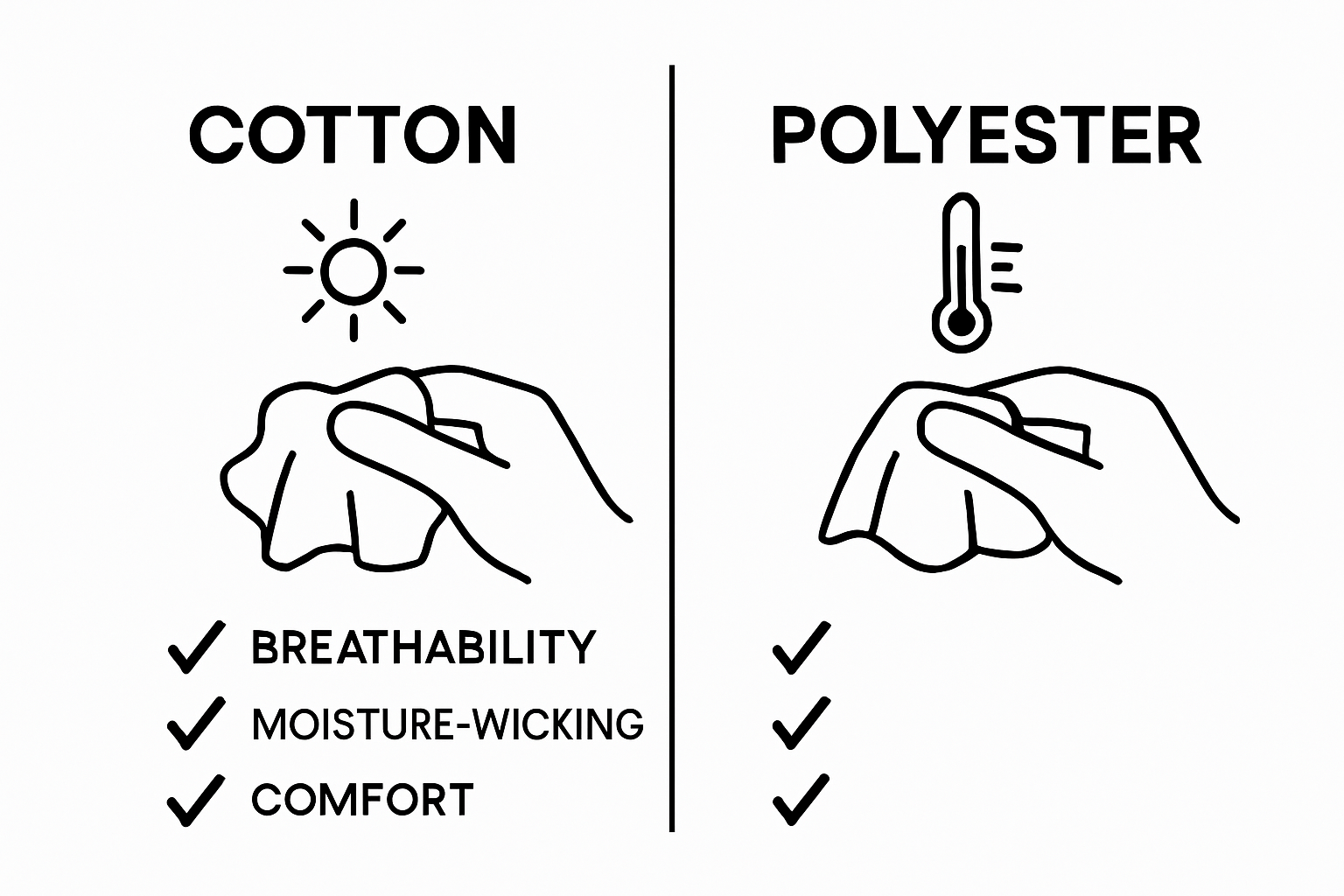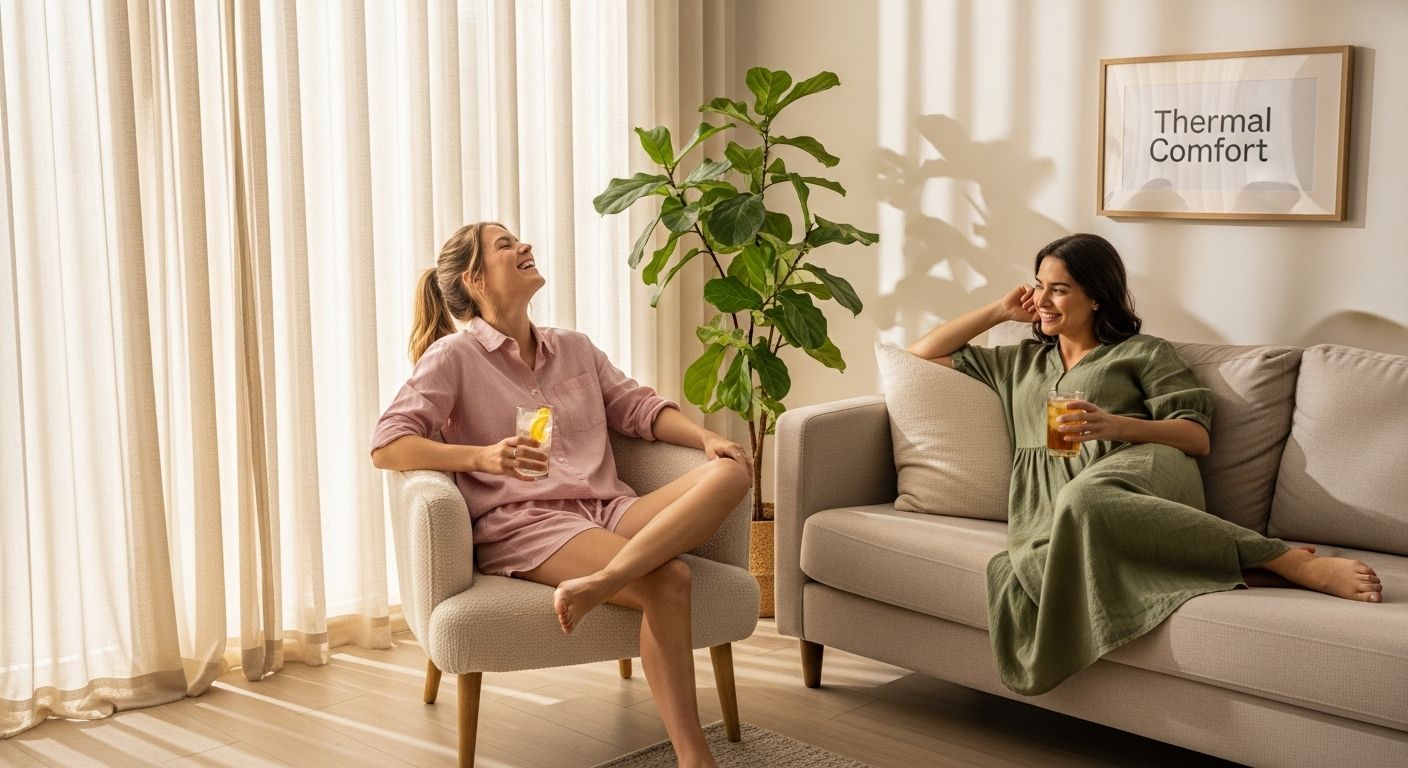Understanding the Best Fabrics for Hot Weather
Understanding the Best Fabrics for Hot Weather

Picking the right fabric can make or break your comfort on a sweltering day. Sweat stains and clingy synthetic shirts are everywhere, you’d think all fabrics fight heat the same way. But that’s way off base. Research shows linen and cotton can wick moisture and breathe far better than polyester. So what makes these superstars so different? The answer will shake up everything you thought you knew about dressing for the heat.
Table of Contents
- What Makes A Fabric Suitable For Hot Weather?
- Why Choosing The Right Fabric Matters For Comfort
- How Natural And Synthetic Fabrics Perform In Heat
- Key Characteristics Of Fabrics Ideal For Warm Days
- Real-Life Examples Of Hot Weather Fabrics In Fashion
Quick Summary
| Takeaway | Explanation |
|---|---|
| Choose moisture-wicking fabrics for heat | Fabrics like linen and cotton effectively pull sweat away, helping maintain comfort in hot conditions. |
| Prioritize breathability in textiles | Natural fibers allow better air circulation, helping to regulate body temperature and prevent heat stress. |
| Consider active cooling technologies in fabrics | Advanced synthetic materials can actively cool the body, enhancing comfort in various environments. |
| Be mindful of long-term health with fabric choices | Prolonged exposure to unsuitable fabrics can lead to skin irritation and increased heat stress, impacting overall wellness. |
| Explore cultural adaptations in textiles | Traditional garments from various cultures exemplify innovative fabric choices that manage heat effectively and stylishly. |
What Makes a Fabric Suitable for Hot Weather?
When choosing fabrics for hot weather, understanding their unique characteristics becomes crucial for maintaining comfort and managing body temperature. Not all textiles are created equal when it comes to heat management, and certain properties determine how well a fabric performs in warm environments.
Moisture Management Properties
The ability of a fabric to handle moisture is paramount in hot conditions. Ideal hot weather fabrics must effectively wick sweat away from the body, preventing that uncomfortable sticky feeling. According to research from Georgia Tech, fabrics like linen excel at moisture transportation due to their unique structural composition.
Key characteristics of moisture-managing fabrics include:
- Rapid sweat absorption capability
- Quick drying properties
- Breathable fiber structures
Thermal Regulation Mechanisms
Fabrics interact differently with heat based on their composition and weave. Some materials allow better air circulation, which helps reduce body temperature. Natural fibers like cotton and linen often provide superior breathability compared to synthetic alternatives. These materials create microscopic air channels that enable heat to escape and cooler air to circulate next to the skin.
The thermal performance of a fabric depends on several factors:
- Fiber density
- Weave pattern
- Inherent material properties
- Surface texture
Scientific Fabric Selection
Modern textile research continues to explore innovative solutions for heat management. Cutting-edge developments have produced fabrics that can actively cool the body, with some advanced materials staying significantly cooler than traditional textiles. University of Chicago researchers have even developed experimental fabrics that demonstrate remarkable temperature reduction capabilities.
By understanding these scientific principles, consumers can make informed decisions about clothing selection, ensuring maximum comfort during hot weather.
Why Choosing the Right Fabric Matters for Comfort
The significance of fabric selection extends far beyond aesthetic preferences, directly impacting personal comfort, health, and physiological well-being. Understanding how different textiles interact with our body can transform the way we approach clothing choices, especially in challenging environmental conditions.
Physiological Impact of Fabric Selection
Clothing is more than a fashion statement it is a critical interface between our body and the environment. According to research in the International Journal of Environmental Research and Public Health, fabric properties play a crucial role in maintaining thermal equilibrium and preventing potential health risks associated with improper clothing.
Key physiological considerations include:
- Body temperature regulation
- Sweat evaporation efficiency
- Skin microclimate management
- Prevention of heat stress
Comfort and Performance Interactions
The right fabric can significantly enhance personal comfort and performance across various activities. Different environments and physical demands require specific textile characteristics. Natural fibers like cotton and linen offer superior breathability and moisture management, making them ideal for hot and humid conditions.
Performance factors influenced by fabric choice encompass:
- Moisture-wicking capabilities
- Temperature adaptation
- Range of motion
- Skin irritation prevention
Long-Term Health Considerations
Beyond immediate comfort, fabric selection has broader implications for personal health. Prolonged exposure to inappropriate textiles can lead to skin irritations, increased heat stress, and compromised thermoregulation. Choosing fabrics that facilitate natural body processes becomes an essential aspect of preventive personal care.
By understanding the intricate relationship between fabrics and human physiology, individuals can make informed decisions that prioritize both comfort and wellness in their clothing selections.
How Natural and Synthetic Fabrics Perform in Heat
Understanding the performance of different fabric types in hot environments is essential for making informed clothing choices. Natural and synthetic materials respond distinctly to heat, with each category offering unique characteristics that impact comfort and thermal regulation.
Natural Fiber Characteristics
Natural fibers are renowned for their breathability and moisture management capabilities. According to research in Materials journal, fabrics like cotton, linen, and bamboo excel in hot conditions by promoting efficient sweat evaporation and air circulation.
Key advantages of natural fibers include:
- Superior moisture absorption
- Enhanced air permeability
- Inherent temperature-regulating properties
- Reduced skin irritation potential
Synthetic Fabric Performance
Synthetic materials, while often engineered for specific performance attributes, present different thermal challenges. Polyester and nylon typically have lower breathability compared to natural fibers, which can lead to increased heat retention. However, modern textile technologies have developed advanced synthetic fabrics with moisture-wicking capabilities that partially mitigate these limitations.
Critical synthetic fabric characteristics include:

- Faster drying times
- Lightweight construction
- Enhanced durability
- Potential for specialized performance treatments
Thermal Comfort Considerations
The ultimate goal of fabric selection is achieving optimal thermal comfort. While natural fibers generally perform better in hot environments, synthetic materials can offer targeted benefits when strategically designed. Advanced engineering has produced hybrid fabrics that combine the best properties of natural and synthetic materials, creating innovative solutions for heat management.
By understanding the nuanced interactions between fabric composition and environmental conditions, individuals can make more informed choices about their clothing, ensuring maximum comfort and performance in challenging thermal scenarios.
To clarify how different fabric types perform in hot weather, the comparison table below summarizes the key attributes of natural and synthetic fabrics, based on characteristics discussed throughout the article.
| Fabric Type | Moisture Management | Breathability | Heat Retention | Comfort Potential |
|---|---|---|---|---|
| Cotton (Natural) | Excellent; wicks sweat | High | Low | Very comfortable |
| Linen (Natural) | Excellent; dries quickly | Exceptional | Very low | Extremely comfortable |
| Bamboo (Natural) | Good; absorbs moisture | Good | Low | Comfortable |
| Polyester (Synthetic) | Fair; fast drying | Generally low | High | Can feel sticky |
| Nylon (Synthetic) | Moderate; dries quickly | Low | High | Less comfortable |
| Engineered Blends | Enhanced; moisture-wicking | Variable (can be high) | Moderate (varies) | Improved with technology |
Key Characteristics of Fabrics Ideal for Warm Days
Choosing the right fabric for warm weather involves understanding a complex set of performance criteria that go beyond simple aesthetic considerations. The ideal warm weather fabric must balance multiple physiological and environmental requirements to ensure optimal comfort and functionality.
Breathability and Air Circulation
Breathable fabrics are the cornerstone of thermal comfort in hot conditions. According to research in the Annals of Occupational and Environmental Medicine, optimal warm weather textiles must facilitate efficient air movement and heat dissipation. Fabrics that create microscopic air channels enable continuous ventilation, preventing heat accumulation next to the skin.
Key breathability factors include:
- Porosity of fabric weave
- Fiber diameter and structure
- Fabric thickness
- Molecular composition of textile
Moisture Management Dynamics
Effective moisture management transforms a potentially uncomfortable fabric into a cooling asset. The ability to quickly wick away perspiration is crucial for maintaining body temperature regulation. Ideal warm weather fabrics rapidly transport moisture from the skin’s surface, allowing it to evaporate quickly and create a cooling effect.
Critical moisture management characteristics involve:
- Rapid sweat absorption
- Quick drying capabilities
- Minimal fabric saturation
- Prevention of skin chafing
Thermal Regulation Properties
Beyond basic comfort, the most advanced warm weather fabrics actively contribute to body temperature control. These textiles leverage scientific principles of heat transfer and evaporative cooling to create a microclimate that helps maintain physiological equilibrium. Advanced materials can reduce perceived temperature by several degrees through intelligent design and innovative fiber technologies.
By comprehensively understanding these intricate fabric characteristics, individuals can make informed decisions that transform their warm weather clothing experience from merely functional to genuinely comfortable.
The following table organizes the essential features that make fabrics ideal for warm weather, consolidating information about breathability, moisture management, and thermal regulation for easy reference.
| Key Feature | Description | Why It Matters in Hot Weather |
|---|---|---|
| Breathability | Allows air to circulate through fabric | Helps release heat and prevents overheating |
| Moisture Management | Wicks sweat away from skin and dries quickly | Reduces stickiness, chafing, and discomfort |
| Porosity | Degree to which fabric weave is open | Facilitates airflow for cooling |
| Thermal Regulation | Ability to help maintain body temperature | Assists in keeping wearer cool and balanced |
| Lightweight | Low weight per area of fabric | Less insulation, promoting heat escape |
| Skin Comfort | Smoothness, softness, non-irritant properties | Prevents rashes and supports all-day wear |

Real-Life Examples of Hot Weather Fabrics in Fashion
Fashion designers and clothing manufacturers strategically leverage fabric properties to create stylish and comfortable warm weather garments. Understanding how different textiles perform in real-world scenarios helps consumers make informed clothing choices that balance aesthetic appeal with physiological comfort.
Natural Fiber Fashion Applications
Cotton and linen dominate summer fashion collections worldwide, providing practical solutions for heat management.** According to research in the International Journal of Environmental Research and Public Health, these natural fibers are extensively used in summer apparel due to their exceptional breathability and moisture-wicking capabilities.
Popular natural fiber fashion examples include:
- Lightweight cotton sundresses
- Linen button-down shirts
- Breathable cotton t-shirts
- Loose-fitting linen trousers
Synthetic Fabric Design Innovations
Modern synthetic fabrics have evolved to address traditional heat retention challenges. Performance textiles now incorporate advanced cooling technologies, enabling designers to create stylish garments that actively manage body temperature. Moisture-wicking polyesters and engineered blends provide lightweight, quick-drying options for active and casual wear.
Innovative synthetic fabric applications feature:
- Athletic performance tanks
- Breathable running shorts
- Lightweight travel clothing
- Moisture-managing business casual wear
Cultural and Regional Fabric Adaptations
Different cultures have long developed unique textile solutions for managing heat, reflecting deep understanding of local environmental conditions. Traditional garments from tropical and desert regions showcase remarkable fabric engineering, utilizing local materials and generational textile knowledge to create clothing that provides optimal thermal comfort.
By exploring these real-life fabric applications, consumers gain insight into how textile science and fashion design collaborate to create clothing that looks great and feels comfortable in challenging warm weather conditions.
Stay Cool and Elegant at Every Special Event
Find yourself searching for a dress that’s beautiful but also comfortable in the heat? Our article explains the struggle of wearing the wrong fabric on a hot day—sticky discomfort, overheating, and lack of confidence when you want to look your best. At Dress Me Up NY, we recognize how critical the right fabric choice is for both style and comfort, especially for proms, weddings, and outdoor celebrations. Our new arrivals and curated collections feature dresses made with breathable, moisture-managing materials inspired by the principles discussed in “Understanding the Best Fabrics for Hot Weather.” Experience sophisticated designs crafted for real-life comfort and elegance so you never have to compromise.

Ready to upgrade your special occasion wardrobe? Explore our latest dresses with heat-friendly fabrics and enjoy exclusive offers only at Dress Me Up NY. Shop now for limited-time savings and find your perfect look for every moment under the sun.
Frequently Asked Questions
What fabrics are best for hot weather?
Natural fibers such as cotton and linen are considered the best for hot weather due to their breathability and moisture management capabilities, allowing for better airflow and sweat evaporation.
How do synthetic fabrics perform in hot weather compared to natural fibers?
Synthetic fabrics, like polyester and nylon, typically have lower breathability than natural fibers, which can lead to heat retention. However, some modern synthetic fabrics offer moisture-wicking properties that help manage heat more effectively.
What factors should I consider when choosing fabrics for warm weather?
When selecting fabrics for warm weather, consider factors such as breathability, moisture management, thermal regulation, and the fabric’s ability to dry quickly to ensure comfort and prevent heat stress.
How does moisture management affect comfort in hot weather fabrics?
Fabrics with effective moisture management quickly wick sweat away from the skin, allowing it to evaporate and cool down the body. This prevents the feeling of stickiness and discomfort associated with excessive perspiration.
Recommended
- Clarisse 811131 Detachable Side Train Strapless Long Dress
- Terani Couture 231GL0439 One Long-Sleeve Tulle Pageant Gown
- Tarik Ediz 53019 Crepe Sweetheart Neck Strapless Long Dress
- Clarisse 810836 Embellished Sequins V-Neck Sleeveless Dress

